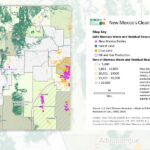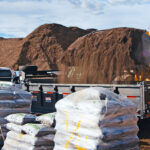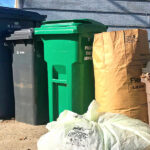
Sally Brown
BioCycle March/April 2019
This is the time of year I start fantasizing about beaches. Warm, sunny, tropical beaches. Feeling the sand underfoot and diving into the waves. Sand is a critical component of that experience. People go to different beaches for the sand. There are pink, white, and even black sand beaches. How cool would it be if you could go to multicolor sand beaches? Beaches with sand made of various colors of glass. It is not hard to make sand out of glass. You just crush it and “sand” it. Beach glass is an example of the partially completed process
Chemically glass and beach sand have a lot in common. Beach sand is typically made up of quartz — silica and oxygen or SiO2. Glass has SiO2 as well. For example, about 73 percent of your IPA bottle is the same as beach sand. The other parts of your bottle are 13 percent sodium and oxygen (Na2O) and 11 percent lime (calcium and oxygen CaO). The remainder of the glass consists of small concentrations of potassium, magnesium, and aluminum — a lot like the salt water that washes up on the beaches.
Most recycled IPA bottles, soda bottles, wine bottles and other sorts of bottles do not end up on the beach (unless you take them there in your cooler). There are multiple end uses for recycled glass including making new bottles, spinning it to make fiberglass, and use as an aggregate in road building.
According to the EPA WARM model (a waste reduction greenhouse gas calculator), recycling glass is also the green thing to do. Unlike paper, glass can be recycled again and again as adding recycled content to virgin glass does not reduce the strength or quality. If it contains recycled glass, your wine bottle typically consists of between 5 and 30 percent recycled materials. About 23 percent of the glass manufactured includes recycled material with the remaining 77 percent being made from virgin material. Recycled glass is easier to melt and so uses less energy to make into new products. The WARM model estimates that you save about 0.53 tons of CO2e per short ton of glass that gets recycled. There are technologies out there to separate the recycled glass into different colors and plenty of firms that do this.
Restoring Beaches
With that said, you can also make the glass into sand. And use that sand to supplement the sand that is already on the beach.
Florida has beautiful beaches. At least they used to have beautiful beaches, a few hurricanes back. At this point, that is not necessarily the case. As of 2010, of the 825 miles of beaches in Florida, 495 miles are classified as either critically or noncritically eroded. Critically eroded means that a portion of the shoreline has eroded to a sufficient degree that upland development, recreation, wildlife habitat or cultural resources are threatened or lost. That 2010 figure was before Hurricane Michael hit this past year. The U.S. Geological Survey (USGS) predicted that the hurricane surge from Michael was likely to erode 75 percent of the Florida Panhandle beaches. After the event, the USGS issued another report suggesting that its prediction was on target. This one even included before and after pictures.
Of course, I am not the only one who likes to go to the beach. According to the Florida Department of Environmental Protection, 18.6 million people come to visit each year to go to the beach. Maybe they stop by to visit with Mickey in Orlando, but the primary reason for traveling to Florida is the beach and not the mouse. A study that I found online by Oxford Economics said that these visitors (2016) spent $112 billion at Florida businesses while they were there. That is a lot of beer bottles. The study went on to say that this spending sustained $88 billion in GDP, and supported 1.4 million jobs with associated wages of $53 billion.
You have a state where tourism makes up a significant portion of the GDP. Those tourists come to go to the beach. Those beaches are eroding, taking away not only tourist dollars but homes of people who actually live in the state. And you have a clear and easy solution! Use recycled glass to make sand and restore those beaches. Everybody benefits! A feel- good story that you can body surf with. This option has even been proposed. Broward County commissioners in 2013 got to decide if they wanted to try this recycled glass to beach concept out, but they decided to not fund an experiment to evaluate the feasibility. Broward has single stream recycling (not clear where the bottles go) but a recent change in the contract has doubled the cost of this option. Some communities in Broward have stopped their recycling programs. Broward is not alone. Marion County said that recycling glass was too expensive and not necessary. After all, glass is inert in a landfill and does not emit methane. Same deal in unincorporated Polk County. So much for the common sense solution, so much for lazing on the sand.
The waste management folks in Florida are not stupid. They have their ratepayers and their bottom line. That bottom line is not connected to the 18.6 million people that come visit their state or to the $112 billion they spend. The people in charge of promoting tourism are likely not even aware of the waste management folks. That is the stupid part. We are well past the point where these types of connections need to be recognized and acted upon. Both sides stand to benefit. Any pain involved on either side — loss of revenue from tourism due to lack of beaches and angry ratepayers for increased recycling costs — can at least partially cancel each other out.
People can feel good about recycling and go have a beer at the beach to celebrate. While there, they can make new friends from out of state. I am not saying that recycled glass for beaches will make all of Florida’s problems go away. I am just suggesting that this is a low hanging, easy part of a solution that we do not have the luxury of ignoring. How about we start doing it now before the tide really goes out?
Sally Brown is a Research Associate Professor at the University of Washington in Seattle (slb@uw.edu) and a member of BioCycle’s Editorial Advisory Board.












